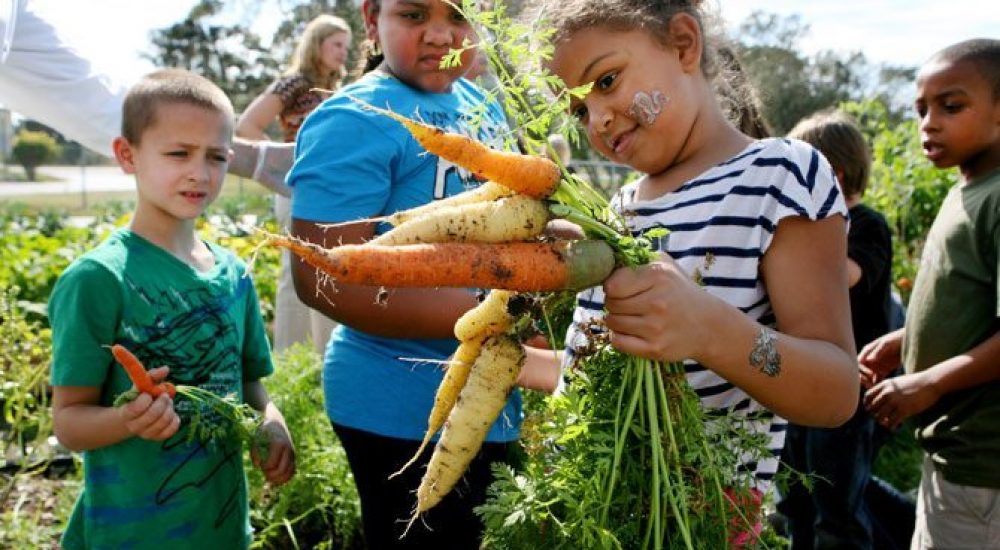Imagine a table full of a diverse range of vegetables and herbs, including chilies, okra, lemongrass, Swiss chard, gourds, figs, and persimmon.
Gardens are places where students can experience all of their senses and be connected to the global world through the natural resources of earth. Gardens, and the people in the community near your garden, are an incredible asset to schools and afterschool programs. Your garden doesn’t have to be perfect or huge – just simply a place where growing and learning can take place.
Academic Enrichment
A study from Rutgers Cooperative Extension, “Learning Through the Garden,” shows that gardens can function as living laboratories, and students who participate in gardening have a considerable increase in grade point average, utilize new learning styles, and develop their perspectives and ways of learning to incorporate critical 21st century skills like “curiosity, flexibility, open-mindedness, informed skepticism, creativity, and critical thinking.”
Here are some activity examples that could be used in a gardening unit:
- Students begin by tending their individual or group plots. After observation of the growth or decay activity in their plot, they can record their learning in an art journal, which can also include charting what foods are grown in global regions.
- Students can go to the kitchen to cook up a new recipe. As your students are working on the recipe, explore culinary traditions, practice global culinary words, and talk about how food connects global regions.
- Research what plants grow in your region versus another region in the world.
- Collect five to ten flowers from the same plant in your garden. Count the number of petals on each flower and create a chart to display your results. Repeat with other types of flowers in the garden. What do the results say about the characteristics of plants? For more math ideas in the garden visit Kids Gardening.
- At the end of an activity, students can take turns practicing leadership with an appreciation circle.
Family and Community Connections
We all know that food brings people together. Gardens are edible, so have students design family and community events around them. Think beyond eating and make it an experience! You can have students find recipes, cook together, decorate the eating space to reflect a highlighted culture, invite local global residents to come and share, and have participants study cultural practices.
Here are some ideas from the California School Garden Network:
- Have students research and showcase cultural or ethnic differences in food consumption and gardening practices. This can be done creatively through poems, interpretative dances, and murals.
- Research cultural dishes and their preparation methods from various origins. Host an “international evening” and provide healthful samplings of fruits and vegetables from those cultures.
- Research cultural holidays and the symbolism of particular fruits and vegetables that are included during those holidays. Plan cultural holiday events to celebrate as family events.
Storytelling
Plan a series where students can meet a gardener each session. This can allow students to develop empathy with farmers and growers around the world. Use video and technology to introduce students to gardeners and growers. Before the live or pre-recorded session, have students research the gardener’s country and culture and develop questions to ask. Garden Mosaics has three stories from gardeners that you can use to start your series.
Intergenerational Relationships
Invite adults to your garden and practice intergenerational learning. As adults and youth garden together, students learn about the heritage and culture of their elders, and they create relationships with respect and trust. This can result in building a stronger community. The elders can find satisfaction of serving in their community while passing along their story and history. Read more about intergenerational learning through gardening here.
Ecological Sustainability
Composting and waste reduction teach students sustainable practices and empower them to be a part of the global community. You could start a “caretakers of the earth” club. In addition, students can explore conservation issues from a local and global perspective. Even planting fruit trees around your neighborhood can contribute to the nutrition and air quality of your community. If such a small act of planting trees on the corner can make a dent in the sustainability of a neighborhood, think about the impact that trees and gardens across the world can make on our global food system!
The world can rely less on oil and natural gas and more on local, fresh foods.1 Visit the Green Education Foundation for garden plans and topics such as water conservation and recycling.
These ideas are just a starting point!
Collaborating with math, science, and art teachers could bring additional ideas of how to use gardens as a hands-on way to enforce what they are learning in those classrooms. Field trips to community gardens and farmers markets can inspire young minds. And if you are in a cold climate, consider learning about greenhouses and hydroponics.
These tools allow farmers to simulate a warmer climate and grow various fruits and vegetables all year long. Gardens – inside or outside, big or small – support academic and 21st century skills development.
Additional Global Gardening Examples and Resources:
Global Gardens: A non-profit organization dedicated to empowering students and communities through hands-on science education.
Life Lab: A national leader in the garden-based learning movement that provides workshops, camps, publications, and youth empowerment and food justice programs.
Slow Food USA: Slow Food USA local chapters, members and volunteers build and maintain school gardens, lead cooking classes and work to improve school lunches.
Global Garden Examples: Toronto, Los Angeles, Chicago
BOOST Collaborative’s Pinterest: Follow BOOST’s Global Garden-Based Learning page for more ideas for your school or out-of-school time program.
1Birch, E.L. & Watcher, S.M. (Eds.). (2008). Growing greener cities. Philadelphia, PA: University of Pennsylvania Press.
Image Source: Successful School Gardens Blog
For breakfast I had eggs, cinnamon toast and an iced coffee.
Author Profile: @kristinstayer

Pingback: Grow Your Program with Gardening - BOOST Cafe